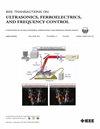Optical-Comb-Based Frequency Stability Transfer Across the Spectrum With a Multichannel FPGA
IF 3.7
2区 工程技术
Q1 ACOUSTICS
IEEE transactions on ultrasonics, ferroelectrics, and frequency control
Pub Date : 2025-01-07
DOI:10.1109/TUFFC.2025.3526761
引用次数: 0
Abstract
Using the optical comb as a transfer oscillator is an effective approach to convert the spectral properties of ultrastable lasers to other wavelength domains. We describe a digital locking system that enables this process to be replicated for several lasers at a time, supporting the simultaneous and independent lock of up to six lasers to a single, high-performance reference oscillator. The locks are robust, easily reconfigured, and contribute a short-term instability lower than利用多通道FPGA实现基于光梳的频谱稳定传输。
利用光梳作为传递振荡器是将超稳定激光器的光谱特性转换到其他波长域的有效途径。我们描述了一种数字锁定系统,该系统能够同时为多个激光器复制此过程,支持多达6个激光器同时独立锁定到单个高性能参考振荡器。锁是坚固的,易于重新配置,并有助于短期不稳定性低于3 × 10-18在1s,即使梳子是在宽线宽的制度下操作,不需要预稳定的从激光器。利用该系统,我们将Yb光晶格时钟的超稳定时钟激光器的相干性转移到1550nm区域的各种从激光器上,包括用于长距离光纤频率传播的激光器,在1秒内的不稳定性小于1 × 10-17。数字化实现实现了模块化方法,增强了对操作参数的控制,最大限度地降低了设置复杂性和硬件相关的不良影响。它还允许立即重新配置和无缝升级,适用于需要不同波长的多个超稳定激光器的应用,例如本地或分布式光学时钟集成,相干光谱和量子模拟。
本文章由计算机程序翻译,如有差异,请以英文原文为准。
求助全文
约1分钟内获得全文
求助全文
来源期刊
CiteScore
7.70
自引率
16.70%
发文量
583
审稿时长
4.5 months
期刊介绍:
IEEE Transactions on Ultrasonics, Ferroelectrics and Frequency Control includes the theory, technology, materials, and applications relating to: (1) the generation, transmission, and detection of ultrasonic waves and related phenomena; (2) medical ultrasound, including hyperthermia, bioeffects, tissue characterization and imaging; (3) ferroelectric, piezoelectric, and piezomagnetic materials, including crystals, polycrystalline solids, films, polymers, and composites; (4) frequency control, timing and time distribution, including crystal oscillators and other means of classical frequency control, and atomic, molecular and laser frequency control standards. Areas of interest range from fundamental studies to the design and/or applications of devices and systems.

 求助内容:
求助内容: 应助结果提醒方式:
应助结果提醒方式:


